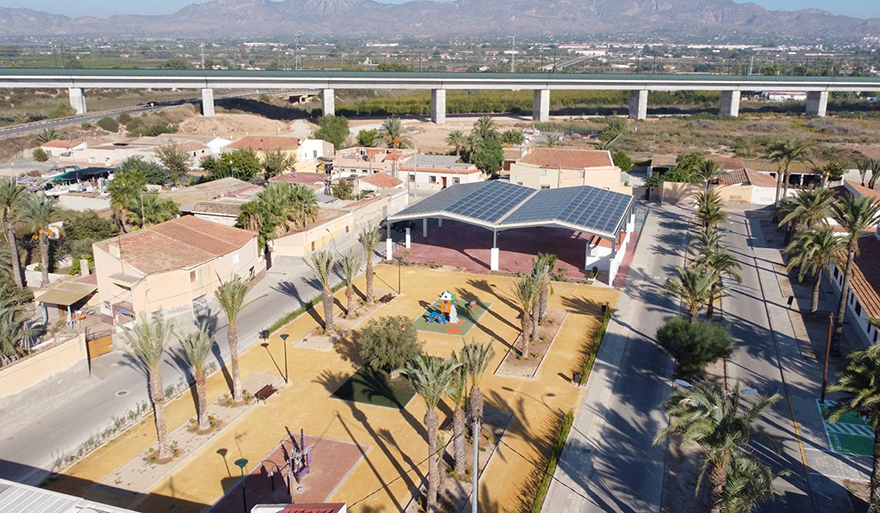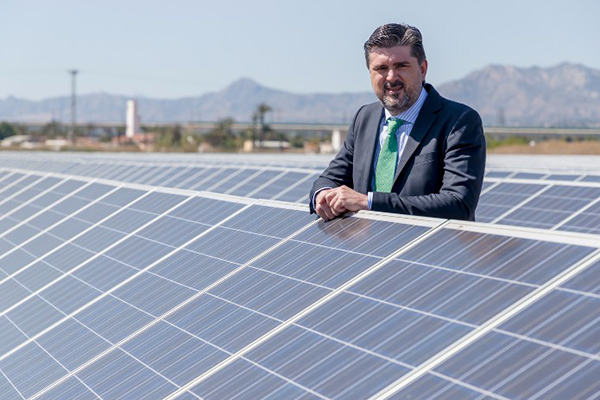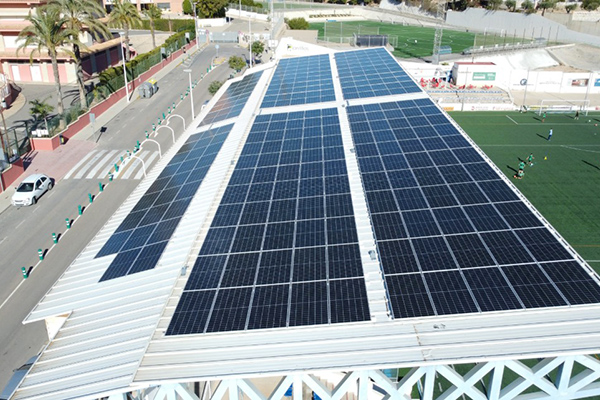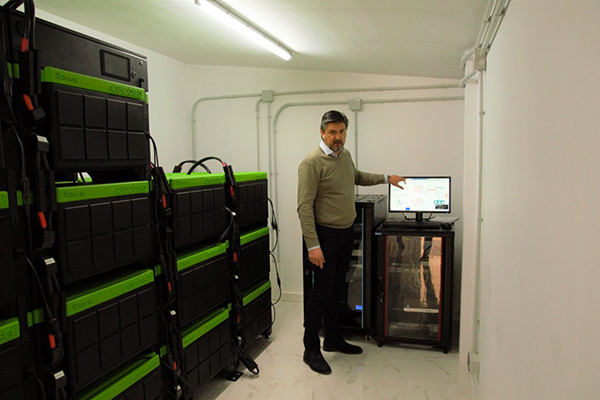In Spain, COMPTEM tests self-consumption on a city scale
Crevillente, a town of 30,000 inhabitants, is testing the feasibility of using a network of solar panels to produce 50% of its electricity. A pioneer in the field, this project is attempting to move self-consumption from the individual to the collective level.

Crevillent (Spain)
He scans the screen of his smartphone, waiting for the verdict to fall... "€273 per Megawatt-hour (MWh) today. Nothing to worry about. Three weeks ago, though, it would have seemed like death. Today, it's a godsend." A year ago it was €28. Electricity prices have been rising ever since. The Russian offensive in Ukraine has caused them to explode. "What can I do to reduce my bill? Produce as much energy as possible myself," Joaquín Mas says. That is exactly what he is doing. For the past three years, he has been laying solar panels on the roofs of Crevillente, a town of 30,000 inhabitants near Alicante, Spain. His aim is to develop a local electricity network that will enable the town to cover 50% of its needs by 2030. Controlled by its users, it is intended to produce green energy that they will consume at an unbeatable price.
Basically, it is a question of applying to an entire city the practice of self-consumption, which allows users to produce themselves the energy they consume. Supported by the cooperative company Grupo Enercoop, of which Joaquín Mas Belso is the general manager, the project is called COMPTEM. It was the first renewable-energy community to be set up in Spain, in 2019. It is one of the pioneers of this movement in Europe.

At the individual level, self-consumption generally consists of installing solar panels on the roof of a house to directly supply its inhabitants with energy. As these panels only produce when the sun is shining, the household remains connected to the conventional grid, from which it draws the electricity it consumes when the panels do not generate enough power. Conversely, during peak production periods, the energy that is not used is fed back into the grid. The user is paid for this. The remuneration is small, but it reduces the bill even more. If equipped with batteries, the system can store some of the excess energy when it produces more than users consume.
"In individual self-consumption, the installations in Crevillente would have cost twice as much"
A renewable-energy community organises a network of such installations, to distribute the energy generated to all its members. As stated in the "roadmap for self-consumption" published by the government in December, this legal entity must be "controlled by its members" and its "primary purpose will be to provide environmental, economic or social benefits to its members or to the local areas in which it operates rather than seeking financial gain". In Valencian, the co-official language in the local autonomous region of Valencia, COMPTEM means: "We count."
"The economies of scale achieved by uniting a larger number of participants always bring prices down," says Eduardo Collado, professor of the Renewable Energy Master's programme at the International University of Valencia and former technical director of Spain’s National Photovoltaic Union (UNEF). "In the case of Crevillente, we are talking about an investment of €4 million to install a production capacity of 5 megawatts (MW). In individual self-consumption, the price could easily be twice as high." This model is also more efficient at managing the energy produced and consumed.
In addition to the savings, this organisation removes some of the barriers to the development of self-consumption and local energy production. Especially in cities. "Imagine: I live in a building. The building across the street blocks the sun. My neighbours don't want to put panels on the roof. I can use an energy community," says Joaquín Mas. He is quick to draw on practical examples to give substance to the theory. COMPTEM is spreading "production cells" throughout the city, perched on the tops of strategic points. These are spaces ceded by the town hall, which welcomes the project with enthusiasm. The locations are copiously watered by the sun, which shines most of the year in this former industrial town. They include the roof of the football stadium, a courtyard installed on a square, etc. Eventually, 21 cells are to be spread throughout the municipality. For the time being, only the first one has been put into service. Four others are ready for service, and the cooperative has announced four more by the end of the year. Enercoop's ambition is to be able to supply all the inhabitants with cheap green electricity.
Another example: "I would like to use green, local and cheaper energy. But I can't afford to put photovoltaic panels on my roof." Here again, the community can help. There are various options for those who can afford to make the investment. They can recoup their investment through a temporary levy on the profits generated. In Crevillente, external investors pay for the production cells. Expected savings? Between 25% and 30% on the bill. At first, half of the money that is not spent goes to reimburse those who have advanced the funds. In theory, the user will not have to pay anything for the deployment of COMPTEM. But they should make a 15% saving once they start using the service.

"For the moment, I don't really see the difference," grumbles Miguel from behind the counter of the only bar in Realengo, a small community of modest white houses on the edge of the city. This is where the first production cell was put into operation in 2020, on the top of a canopy installed for this purpose on a square in the neighbourhood. This "pilot cell" is equipped with batteries, which can store up to 240 KWH when the sun comes and give it back when it goes away.
"But I don't know if it's because it doesn't work, or if it's because of the increase in electricity prices, as they say," continues the barman. He confesses that he has never really used the energy community’s app. This informs users about the state of production and MWH reserves, as well as about their own consumption. It is supposed to allow them to better plan according to the day's sunrise and sunset. "But in my bar, everything is on from opening to closing," he says. A few doors on, Ramó Triero comments: "I've been to several meetings. It seems to me to be a very good thing. Even more so in the current situation." He has signed up but has not yet been connected. "It made me want to put solar panels on my house."
Benefits for us, benefits for you
In Spanish, COMPTEM also stands for "Community for Municipal Ecological Transition." Local production and consumption of electricity is part of the answer to the greatest challenges of our time. Chief among these is climate change. The Spanish government expects to install between 9 and 14 gigawatts (GW) of self-consumption generation capacity by 2030. This represents at least a quarter of the 39 GW of total solar generation capacity that Spain plans to install by that date. This would amount to between 5.6 and 8.7% of total electricity production by the end of the decade. The practice can bring large amounts of green energy into the system. "Given the scale of the targets set for the next ten years, it is very important to mobilise all the contributions that can be made. This type of initiative is therefore welcome," concludes Eduardo Collado.
The outbreak of war in Ukraine a month ago was a stark reminder of another reality for the European Union: its huge energy dependence on countries like Russia. "We need to act now to mitigate the impact of rising energy prices, diversify our gas supply for next winter and accelerate the clean energy transition. The quicker we switch to renewables and hydrogen, combined with more energy efficiency, the quicker we will be truly independent and master our energy system," said European Commission President Ursula von der Leyen in her introduction to the presentation of the "Repower Europe" plan on 8 March. EU countries have few fossil-fuel resources in their subsoil. Yet fossil fuels account for more than two-thirds of their consumption.
"We are not developing COMPTEM in Crevillente just because the community says it is good. Europe tells us so, the Ministry for Ecological Transition tells us so, the Region tells us so," Joaquín Mas stresses. The EU has been focused on the subject for the last few years. Several directives require member states to adopt policies that promote these initiatives. Last December, the Spanish government published a "roadmap for self-consumption". "Energy communities are strongly encouraged. Many projects receive 40-50% of their funding in the form of grants," confirms the general manager of the cooperative. The EU itself has stumped up cash, subsidising the batteries installed in Realengo by up to 70%. The NextGenerationEU recovery plan, designed to rebuild a "greener, more resilient, more digital" Europe in the wake of the pandemic, is expected to take over later. Last February, Spain’s Ministry for the Ecological Transition announced the distribution of a €40 million tranche of the recovery mechanism destined to "encourage singular pilot projects of energy communities".

Self-consumption is not a magic bullet
The sector is currently booming in Spain. Soaring energy prices have made many users take the plunge. At this rate, the 2030 targets could well be reached ahead of schedule. "If they are not, it will not be for lack of interest on the part of private players," says the man who runs COMPTEM. One issue is the complexity of the administrative procedures to be undertaken.
But we must be careful not to fall into naive utopianism, warns Eduardo Collado. Those who dream of a world of small, independent local networks, free of the large electricity companies and their dominant position, are likely to be disappointed. "Wind and solar power are not manageable [because it is difficult to supply the grid at night when the wind is not blowing]. Spain also needs large storage projects to be developed." COMPTEM insists that energy communities will have a role to play in the coming years to meet this challenge. "As far as manageability is concerned, I would have more confidence in large installations," admits the professor of the Renewable Energies programme at the International University of Valencia. As for price moderation, there is no guarantee: "The town halls will be able to make certain areas available. But apart from that, people will probably try to make a profit on the assets they own," says the former UNEF president.
"COMPTEM is a very small project," he concludes. "But it is a very good example of what municipalities and regions can do." And no doubt an excellent PR coup for the Enercoop group, which has incontestably attracted a lot of media attention.
 This article was produced as part of the Union Is Strength competition, organised by Slate.fr with the financial support of the European Union. The article reflects the views of the author and the European Commission cannot be held responsible for its content or use.
This article was produced as part of the Union Is Strength competition, organised by Slate.fr with the financial support of the European Union. The article reflects the views of the author and the European Commission cannot be held responsible for its content or use.